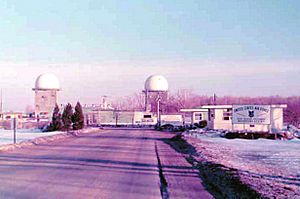Watertown Air Force Station facts for kids
Quick facts for kids Watertown Air Force Station |
|
|---|---|
| Part of 1951-1968: 1968-1979: 1979-1984: |
|
| Watertown, New York | |

2 radomes and the main gate with guard shack (1975)
|
|
| Coordinates | 43°55′31″N 075°54′33″W / 43.92528°N 75.90917°W |
| Type | Long Range Radar Site |
| Code | RP-49: 1950 ADC permanent network Z-49: 1963 July 31 NORAD network |
| Site information | |
| Controlled by | |
| Site history | |
| Built | 1952 |
| Built by | U.S. Air Force |
| In use | 1952-1979 |
| Garrison information | |
| Garrison | Watertown, New York |
| Occupants | 655th Radar Squadron |
Watertown Air Force Station was a special place in Watertown, New York, that used to be a United States Air Force base. It was like a giant set of eyes and ears for the country. Its main job was to watch the skies for anything unusual. This station was active from 1952 until 1979.
It was located about 3.5 miles (5.6 km) south of Watertown. After the Air Force radar squadron left in 1979, another part of the Air Force kept using some equipment until 1984. Today, a New York State jail is located at the site.
Contents
History of the Radar Station
Early Days and First Radars
The story of Watertown Air Force Station began in June 1950. A temporary radar site, called L-6, was set up at the nearby Pine Camp military base. This base was later renamed Fort Drum in 1951. The 655th Aircraft Control and Warning Squadron operated this early radar. They used a radar system known as the RCA AN/TPS-10A.
In June 1952, the operations moved to the new Air Force Station. This new station was built right next to Fort Drum. It was one of the first 24 permanent radar stations built by the Air Defense Command. These stations were set up between 1950 and 1951.
Watching the Skies
Watertown Air Force Station used powerful radars to do two main things. First, they provided early warnings of anything approaching. Second, they helped guide friendly aircraft to intercept unknown planes. They used radars like the AN/FPS-3 and AN/FPS-5 for these tasks.
By 1958, the station had upgraded its equipment. It was using an AN/FPS-20 radar to search the skies. It also had a General Electric AN/FPS-6 radar to measure how high objects were flying.
Joining the SAGE Network
In 1959, Watertown Air Force Station became part of a new system. This system was called the Semi Automatic Ground Environment (SAGE). SAGE was a huge computer network. It helped track aircraft and guide defenses automatically. Watertown AFS sent its radar information to a main SAGE center in Syracuse, New York. Because of this new role, the squadron changed its name to the 655th Radar Squadron (SAGE) in February 1959.
More radar upgrades happened in the following years:
- In 1959, a second AN/FPS-6 radar was added.
- In 1961, the AN/FPS-20 radar was improved to an AN/FPS-66.
- In 1963, one of the height-finder radars was replaced with a newer AN/FPS-26.
- In 1964, the AN/FPS-66 was replaced by an even more advanced AN/FPS-27 radar. The other AN/FPS-6 radar was retired that same year.
Gap Filler Sites
Besides the main station, the Watertown squadron also managed two smaller, unmanned radar sites. These were called "Gap Filler" sites. They were like smaller eyes that filled in any blind spots the main radar might have missed.
- One site, called P-49A, was located at Suttons Corner, New York.
- The other, P-49B, was in Oswegatchie, New York.
Air Force Units and Their Jobs
Units at the Station
The main unit that worked at Watertown Air Force Station was the 655th Aircraft Control and Warning Squadron.
- It started on December 8, 1949, at Pine Camp, New York.
- It moved to Watertown AFS on February 1, 1951.
- It changed its name to the 655th Radar Squadron (SAGE) on February 1, 1959.
- It changed its name again to the 655th Radar Squadron on February 1, 1974.
- The squadron was officially closed down on November 1, 1979.
Who They Reported To
The 655th squadron was part of different larger Air Force groups over the years. These groups helped organize and manage all the radar stations.
- From December 1949, it was part of the 540th Aircraft Control and Warning Group.
- From February 1952, it was part of the 32nd Air Division.
- From February 1953, it was part of the 4711th Air Defense Wing.
- It returned to the 32nd Air Division in March 1956.
- From September 1958, it was part of the Syracuse Air Defense Sector.
- From September 1963, it was part of the Boston Air Defense Sector.
- From April 1966, it was part of the 35th Air Division.
- From November 1969 until it closed, it was part of the 21st Air Division.

